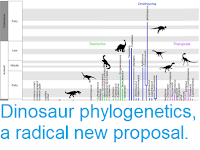Sauropod Dinosaurs are the largest known land animals ever to have walked the Earth, with some species reaching masses of around 60 tonnes, larger than any member of any other Dinosaur group, and exceeded only by the modern Baleen Whales (which are fully marine in nature). These Dinosaurs descended from the Prosauropods, a polyphyletic group (i.e. a group which does not include all the descendants of their most recent common ancestor, since Sauropods are not considered to be Prosauropods; polyphyletic groups are not considered valid by many modern taxonomists) which includes early bipedal forms, and which may have split of from other Dinosaur groups before the Ornithischia/Saurischia split, with the two groups being together known as the Sauropodomorphs.
In a paper published in the journal Current Biology on 28 September 2018, Blair McPhee of the Departamento de Biologia at the Universidade de São Paulo, and the Evolutionary Studies Institute at the University of the Witwatersrand, Roger Benson, also of the Evolutionary Studies Institute at the University of the Witwatersrand, and of the Department of Earth Sciences and of the University of Oxford, Jennifer Botha-Brink of the National Museum in Bloemfontein and the Department of Zoology and Entomology at the University of the Free State, Emese Bordy of the Department of Geological Sciences at the University of Cape Town, and Jonah Choiniere, also of the Evolutionary Studies Institute at the University of the Witwatersrand, describe a new species of giant Sauropodomorph Dinosaur from the Earliest Jurassic of southern Free State, South Africa.
The new species is named Ledumahadi mafube, where 'Ledumahadi' means 'a giant thunderclap' and 'mafube' means 'dawn', both in Southern Sotho, in reference to the large size of the species, and its place early in the history the group. The species is described from a partial cervical neural arch, several dorsal vertebrae, a partial conjoined primordial sacral vertebrae, an anterior and a middle caudal vertebrae, an anterior chevron, a right ulna, a first metacarpal, a left metacarpal, probably III or IV, the distal third of the right femur; and a pedal ungual, all from Beginsel Farm, a location 25 km southeast of the town of Clarens in Free State Province, and close to the the border with Lesotho.
Selected Preserved Elements of Ledumahadi mafube and Geography and Stratigraphy of Type Locality. Preserved bones (A–K) are as follows: (A) middle/posterior cervical vertebra in left lateral view; (B) anterior dorsal vertebra in anterior and right lateral views; (C) middle dorsal vertebra in posterior and right lateral views; (D) first and second ‘‘primordial’’ sacral vertebrae in left lateral view; (E) anterior caudal vertebra in left lateral view; (F) right ulna in proximal and medial views; (G) first metacarpal in proximal and ?dorsal/ventral views; (H) left ?third metacarpal in proximal and ventral views; (I) pedal ungual in ?lateral and proximal views; (J) anterior chevron in posterior view; and (K) distal right femur in distal, lateral, and anterior views. (L) Simplified geological map of the Elliot Formation in the Republic of South Africa and Lesotho indicating the location of farm Beginsel 346 and aerial extent of the Elliot Formation outcrop area. (M) Landscape view of the local geology at the Ledumahadi site. Note that the contact of the lower and upper Elliot Formations (LEF and UEF, respectively) has been identified at 1685 m above sea level; thus the UEF is 60 m thick. The poorly exposed LEF, which is 10 m thick here, only contains massive mudstones with very weakly developed pedogenic alteration features, green-gray mottles, and very rare desiccation cracks. Abbreviations: ap, anterior process; ns, neural spine; op, olecranon process; poz, postzygapophysis; rf, radial fossa; sr, sacral rib; tfc, tibiofibular crest; vt, ventral tubercle. All scale bars represent 5 cm. McPhee et al. (2018).
The specimen is thought to have been about 14 years old at the time of its death, based upon dark rings in its long bones representing annual temporary decreases in growth due to seasonal climatic variation, though such ages are not completely precise, as the evidence of the earliest bone development is destroyed by secondary remodelling, and to have weighed about 12 tonnes, with fore-limbs modified into column-like forms similar to those seen in later Sauropods. Since Ledumahadi mafube is not thought to be ancestral to these forms, it represents a remarkable independent and parallel development of both rapid growth and column-like forelimbs from a bipedal ancestor in a separate Sauropodomorph group, which occurred shortly after the End Triassic Extinction. This is particularly notable as Ornithischian Dinosaurs, which underwent several separate transitions from a bipedal to a quadrupedal gait, never evolved column-like forelimbs, suggesting that making this transition was an ability unique to Sauropodomorphs.
See also...
Follow Sciency Thoughts on Facebook.







